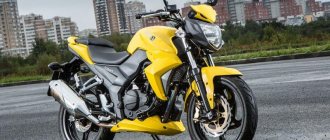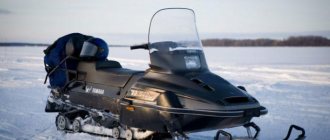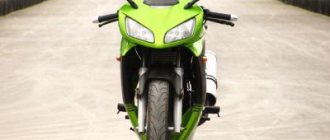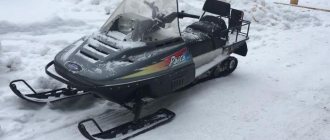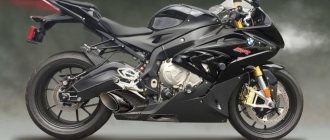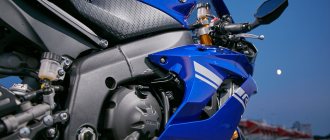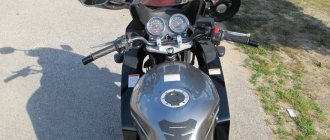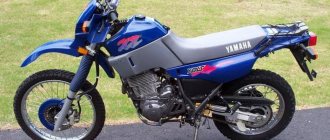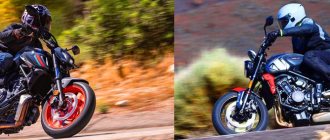BMW K1100LT
Model class : tourist
Years of production/sales : 1991-1998
BMW K1100LT model appeared in 1991 and replaced the BMW K100LT. The abbreviation LT stands for Luxury Tourer and denotes a class of full-fledged touring motorcycles.
Unlike the old K100LT model, the new one receives a number of improvements and differences:
- New 1092 cc engine. see with an increased compression ratio (11.0:1) and a new injector (Bosch Motronic MA 2.2).
- New plastic body kit with improved protection from wind and rain.
- New Brembo brake system with ABS I or ABS II (from 1993).
- New rear suspension –
- Electrically adjustable windshield.
- Quick-release central and side cases.
- Increased curb weight - from 263 to 290 kg.
Otherwise, the BMW K1100LT model has all the features of the K-series touring motorcycles: a 4-cylinder horizontal in-line liquid-cooled engine, fuel injection, ABS, proprietary Paralever rear suspension and a huge list of touring options - radio, heated grips, 12V sockets, adjustable windshield, pannier system, etc.
During the entire production period of the BMW K1100LT model, from 1991 to 1998, 22,757 motorcycles were produced. Despite the high initial price, the model was extremely popular in Europe. In 1999, the BMW K1100LT was replaced by the BMW K1200LT.
In parallel, since 1992, a lighter sports-touring version of the BMW K1100RS was also produced, built on the basis of the frame, chassis and engine from the BMW K1100LT.
MY MOTORCYCLE
This is not my first motorcycle (both in general and custom). But probably the stupidest one. I bought it a couple of years ago for cheap. Decommissioned police officer from England. At first I wanted to return the original appearance of a tourist. But I looked at this miracle carefully, googled it and decided it would be a good thing. I immediately decided: there will be spoked wheels. I bought a goose from the 1100th on eBay. The rear one went in relatively easily; I just had to replace the brakes (from the same “goose”) and move the lower shock absorber mount. And I had to tinker with the front wheel. I machined new axles and bushings. The LT has a narrower fork and the wheel fits with 5mm clearance on both sides. I made the wing myself.
The wiring ate up my nerves for 10 years to come. The motorcycle had the entire package from BMW for 1999: ABS, heated grips, walkie-talkie, sirens, flashing lights... Everything was connected through a lot of different relays... I struggled for a week, then gave up - I cut everything off. I left only the injection control unit and the air temperature sensor. I did all the wiring again. I welded the tail cap from aluminum and hid everything there.
BMW has a peculiarly curved frame under the seat. And style requires a straight line (preferably from the handlebars to the tail.) In Latvia, you can’t cut frames, you had to cheat. The seat (on an aluminum base) was covered with light leather, and a black insert was made above the bend of the frame. Visually the bend has disappeared. I didn’t change the tank, I just cut off the excess and polished the neck. Instead of a steering wheel there are clip-ons from Kawasaki ZX-10R. I ordered milled brake and clutch levers on eBay. It took me a long time to select a speedometer. Most of those offered now are small (6 cm in diameter), but I wanted to be closer to the classics. I ended up ordering from Louis. All in one: speedometer, tachometer, indicator lights, no chrome and 9 cm in diameter. The steering wheel was also freed up: the buttons are only on the left, in the remote control from an old Honda. I found the grips on eBay. In America, an old motorcycle shop was selling out, and I bought Japanese pens from the 60s in their original moldy packaging - complete primitive plastic, but it suited me just fine. The car ignition switch was hidden on the left under the tank. The motorcycle now starts with a key, like a car.
I made the footpegs, brake and gear levers myself. Temperature and gasoline sensors are from LT: round, classic. I decided to leave them. I machined housings for them in the same style as the brake fluid reservoirs and installed them at the level of the bottom of the tank, on the right. I made “pipes” from stainless pipes, flaring them with a press. I installed them parallel to each other and covered them with mesh. The original muffler was sawed off to the junction of all four pipes. Continued with a muffler from an old Honda. The engine, gearbox, rear axle and gearbox took a long time to be cleaned of paint (all of it is black on the LT).
Turn signals are diode. The brake light and tail light are the smallest of all that I found on the Internet (we require a marking of compliance with European standards, so the choice is limited). I also ordered a headlight on eBay: large, chrome, classic. I couldn't decide on a color for a very long time. The result is blue, like on the BMW emblem (without metallic, the old fashioned way). The rest is the simplest silver metallic, and a narrow black line for contrast.
The motorcycle is very light. Much of this seems to be due to the low center of gravity. The motor lies, and there is practically nothing above it. It's easy to drive, but you won't go far. The seating position is sport-like, with a strong forward lean. But you can drive it - it pulls like a locomotive!
Issue: MOTO Magazine - December 2015
Author: Leonid STEFAN (Valmiera, Latvia) and Dmitry FEDOTOV, photo by the author
Brief history of the model
- 1991 – start of production and sales of the BMW K1100LT.
- 1993 – appearance of the SE (Special Edition) modification. It is distinguished by the presence of ABS II and a number of additional options (the capacity of the central case is 9 liters larger, the presence of a passenger backrest, two additional stereo speakers)
- 1997 – appearance of the Highline modification. In terms of equipment, it resembles the Special Edition, but differs in the original colors and chrome trim of the motorcycle parts.
- 1998 is the last year of production of the BMW K1100LT.
- 1999 – The BMW K1100LT is replaced by the new BMW K1200LT model.
Links[edit]
- ^ ab Mark Cook (December 2000), "Return of the Original Oil Head", motorcyclist
- ^ a b Edwards, David (October 1994), "Best Standard Motorcycle: BMW R1100GS", Cycle World
,
33
(10):45 - ^ ab "BMW history: BMW celebrates its anniversary / new boxer". BMW Motorrad. Retrieved May 19, 2013. 70 years after the R 32 of 1923, BMW presents the sports-touring BMW R 1100 RS at the start of the 1993 season, the first model of the new generation of boxers, followed a year later by the enduro model BMW R 1100 GS.
- ↑
Clement Salvadori (March 3, 1994), "Updated boxer engine delivers plenty of power on the road",
Orlando Sentinel
, retrieved May 19, 2013. - ^ab Kevin Cameron (January 1993), "Brave new Beemer", Cycle World
,
32
(1):45, ISSN 0011-4286 - Bill Stoermer (July 2005), "2005 BMW R1200ST", Rider
: 42, As with all BMW winos... the engine function is like a tense member; Various subframes are firmly attached to it to support the fork, seat and associated components. - Mark Zimmerman (2003), BMW Motorcycle Buyer's Guide, Motorbooks International, p. 106, ISBN 0-7603-1164-1, The R1100RS was the first oil trap to be produced.
- ↑
Kevin Cameron (December 21, 2012), "BMW's All-New Water-Cooled Boxer - Technical Review: It Only Took 90 Years...",
Cycle World
Specifications
Technical characteristics of BMW K1100LT:
| Model | BMW K1100LT |
| Motorcycle type | tourist |
| Year of issue | 1991-1998 |
| Frame | tubular spatial, engine - load-bearing element |
| engine's type | 4-cylinder in-line, horizontal |
| Working volume | 1093 cc |
| Bore x Stroke | 70.5x70 mm |
| Compression ratio | 11.0:1 |
| Cooling | liquid |
| Number of valves | DOHC, 4 valves per cylinder |
| Fuel supply system | injector Bosch Motronic MA 2.2 |
| Ignition type | electronic |
| Maximum power | 100 hp at 7500 rpm |
| Maximum torque | 107 Nm at 5500 rpm |
| Transmission | 5-speed |
| type of drive | cardan |
| Front tire size | 110/80 ZR 18 |
| Rear tire size | 140/80 ZR 17 |
| Front brakes | 2 discs, 305 mm, 4-piston calipers (ABS) |
| Rear brakes | 1 disc, 285 mm, 2-piston caliper (ABS) |
| Front suspension | Telescopic fork, travel - 135 mm |
| Rear suspension | pendulum BMW Paralever, stroke - 120 mm |
| Overall dimensions (LxWxH) | 2250 x 915 x 1450 mm |
| Seat height | 810 mm |
| Gas tank capacity | 22 l (including reserve - 5 l) |
| Maximum speed | 210 km/h |
| Acceleration to 100 km/h (0-100) | 4.3 sec |
| Motorcycle weight (curb) | 290 kg |
Driver comfort
The motorcycle seat is quite wide, made very well and leaves only a pleasant riding sensation, as does the seating position in general. Depending on the height and build of the rider, there are three stages of adjustment, this provides additional comfort and useful variability in riding position for a wide range of users. The wind protection of the motorcycle is also satisfactory. As a separate positive point, it is worth highlighting the ability to adjust the height of the windshield, which will allow you to get more emotions from the incoming air currents during dynamic driving in dry weather, and in bad weather it makes it possible to stay dry on the road for a long period of time.
In the basic configuration, the bike is equipped with adjustable heated handlebar grips; the option takes driving comfort to a new level and provided reviews of the BMW R1100RS as a vehicle suitable for use in the cold season, as well as for long-distance motorcycle trips.
Unexpectedly light
Thanks to the carefully calibrated weight distribution of the motorcycle, calculated ergonomics of the driver's position, as well as competent tuning of high-tech suspensions, the BMW R1100RS model is much easier to control than one might expect. At near-zero speeds, you still have to make some efforts when maneuvering and turning, which is affected by the impressive dimensions and weight of this solid motorcycle. But everything changes as soon as the speedometer needle rises above the mark of twenty kilometers per hour: all the clumsiness of the bike disappears somewhere, and all that remains is to admire how confidently the model holds the chosen trajectory and copes with side winds, which is something you can’t handle when driving a lighter motorcycle. some difficulties might arise.
Devices in sight
The instrument panel of the motorcycle is very informative and is easy to read in motion both in good light and in backlight or at dusk. Key gauges like the speedometer and tachometer are right where you'd expect them to be, and readings are only a matter of quick glances at the dials. In addition, there are indicators for oil and fuel levels, engine temperature, the value of the currently selected gear, as well as a digital clock. The mirrors on the BMW R1100RS are quite small, but there are no problems with viewing what is happening behind you due to their good location. In addition, they do not vibrate at all. The power reserve is about two hundred and fifty kilometers with fairly dynamic driving in a mixed driving cycle both in city traffic and when moving on the highway. The predicted travel range without the need to visit a gas station in highway driving conditions can be about 350 kilometers.
